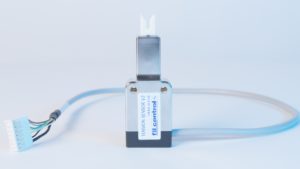Yarn Tension Sensor – Piezo-electric
Yarn Tension Sensor V2 – SAVIO TYPE
?Tension Sensor V2 characteristics:
Application: The yarn is expected to run in a backward and forward motion. Tension sensors are used to measure the dynamical tension in a moving yarn and regulate the tension of the yarn on a winding machine.
Principle: Tension sensors are dynamical tension devices. The piezoelectric element mounted on a flexible beam is the most important part of tension sensors. The force on the ceramic is linked to the output voltage of the tension sensor. The frequency of this voltage is the result of the frequency of the backward and forward motion of the yarn. There are filters to cut-off the unused frequencies.
Calibration: Tension sensors are calibrated to supply all sensors in a range of 16% of dispersion.
Fil control tension sensor adapted for use with a textile yarn process. An elongate spring arm having one end adapted to be fixedly mounted to a textile yarn processing machine and an opposite free end deflectable direction with respect machinery.
It will guide surface to the free end of said arm for engaging a running yarn.
The tension sensor in the running yarn will deflect the free end in order to deflecting direction, and means for damping the deflecting movement of said free end of said spring arm, with receptacle supporting a magnetic fluid. more information here
Download our Brochure here
Brochure Tension Sensor
Tension sensor Electrical characteristics
- Parameters Conditions Min Typ Max
- Power supply (V) 4.5 5 5.5
- Temperature (°C)
- Storage
- Operating
- Humidity relative (%) 80%
- Dynamical tension on the ceramic (en g) 1 20
- Static force(g) 100
- Calibration voltage mV (CAG1=0 and CAG2=0) for 10g on the ceramic at 18 Hz. 327 355 385
- Frequency (Hz) Ripple lower than 1dB in bandpass 3 45
- Calibration (%) -8 0 +8
- RMS voltage (V) 0 1.4
Connections
Sensor’s pin number Function
1 Shielding
2 GND
3 Vout
4 For factory calibration – Do not use (CS)
5 D or CAG2
INC or CAG1
7 +5V
Mechanical tension range.
- CAG1 CAG2 Mechanical force on the ceramic (F)
- Ground Ground 0 à 20 g
- +5V Ground 0 à 10 g
- Ground +5V 0 à 5 g
- +5V +5V 0 à 2.5
The function of tension sensor
In the manufacture and processing of multi-filament yarns, such as the false twist texturing operation, the tension sensor is the key process parameter to optimise your production.
With the temporary fluctuations of the yarn tension variation , the sensor will influence significantly the quality of the yarn,
The satisfactory yarn tension sensor must have an adequately high natural frequency so as to be adapted to follow the frequency of the fluctuations of the tension.
This requirement presents technical problems, because you have to know that the vibrations of the machine itself may lead to oscillations of all tension sensors.
Fil control has developped a solution to provide a yarn tension sensor which is able to follow the fluctuations of the yarn tension, and which is relatively insensitive to machine vibrations and other external disturbances.
Fil Control offers 4 types of sensors:
Capacitive sensors
Monitor the tension variations produced by the electrical charges into the yarn in linear motion.
(PA, PE, PES, PP, Spandex …)
Optical sensors
Thanks to infrared beam, optical sensors control the presence of the yarn during linear, to-and-fro or ballooning motion.
Piezo-electric sensors

Monitor a very slow motion or record yarn vibrations of the yarn sliding on ceramic.
Electromechanical sensors
Are used when the presence or absence of the yarn must be controlled at a lower cost.
More information about yarn tension sensor click?here
Ask us for a quote







